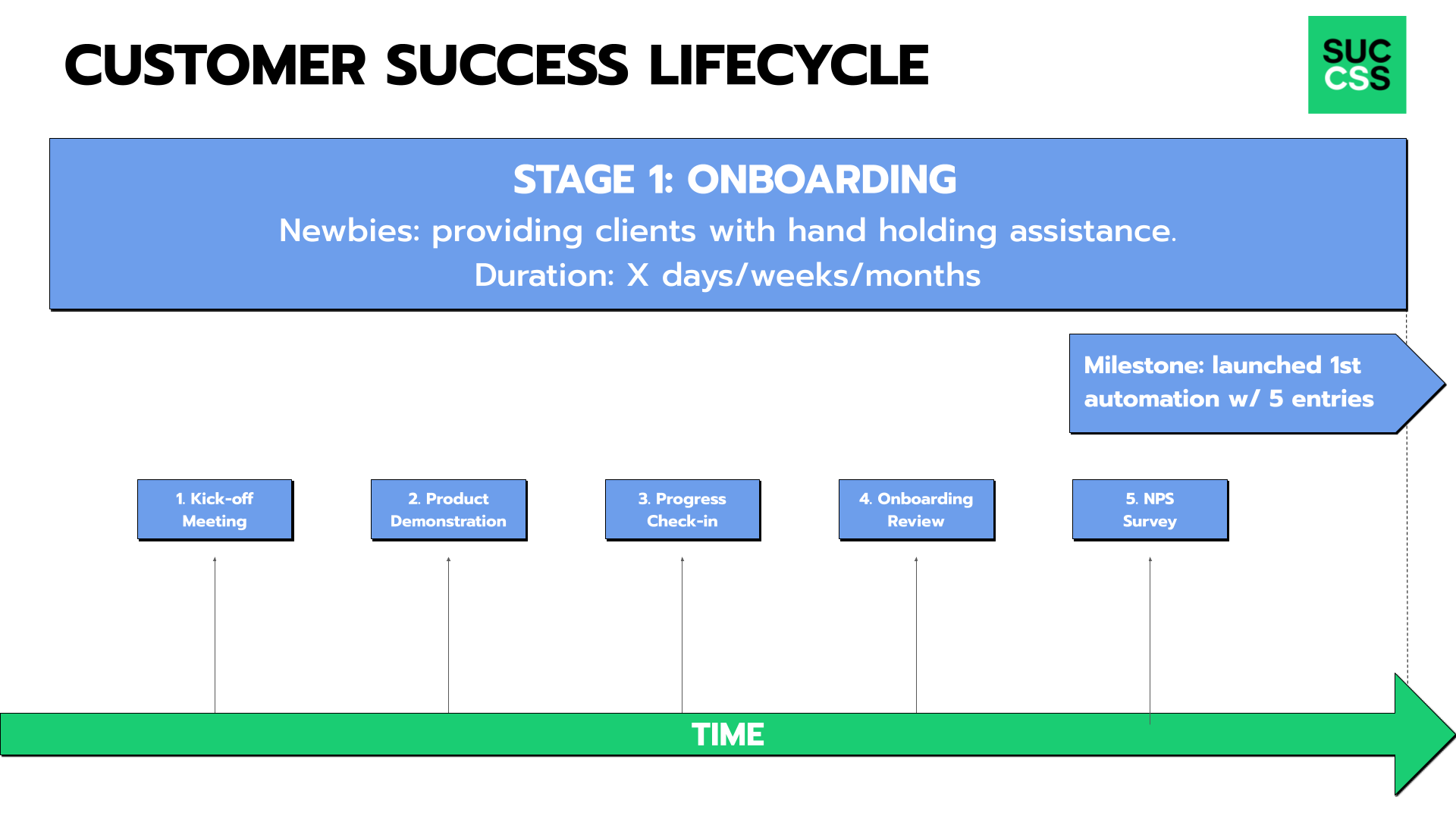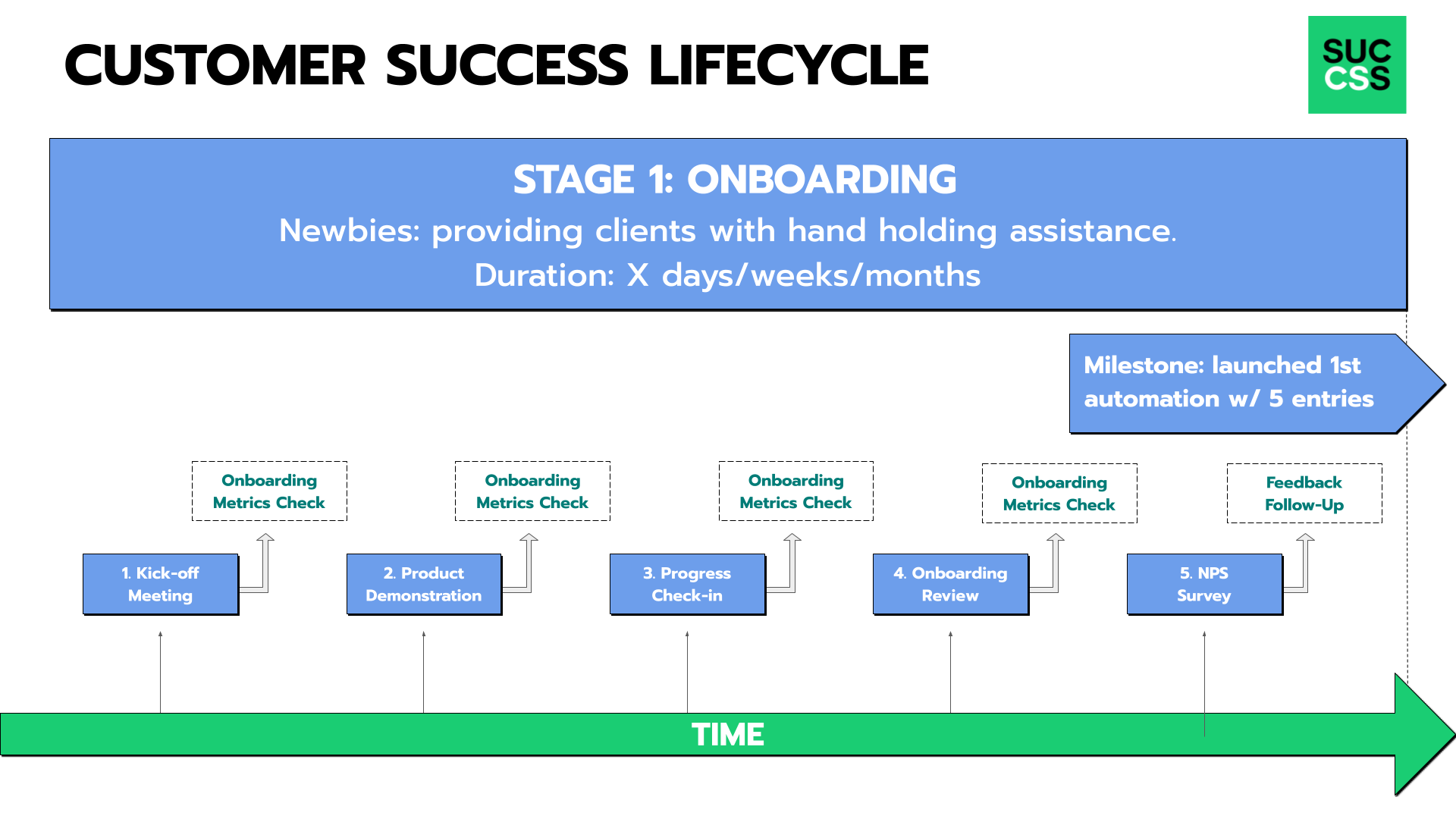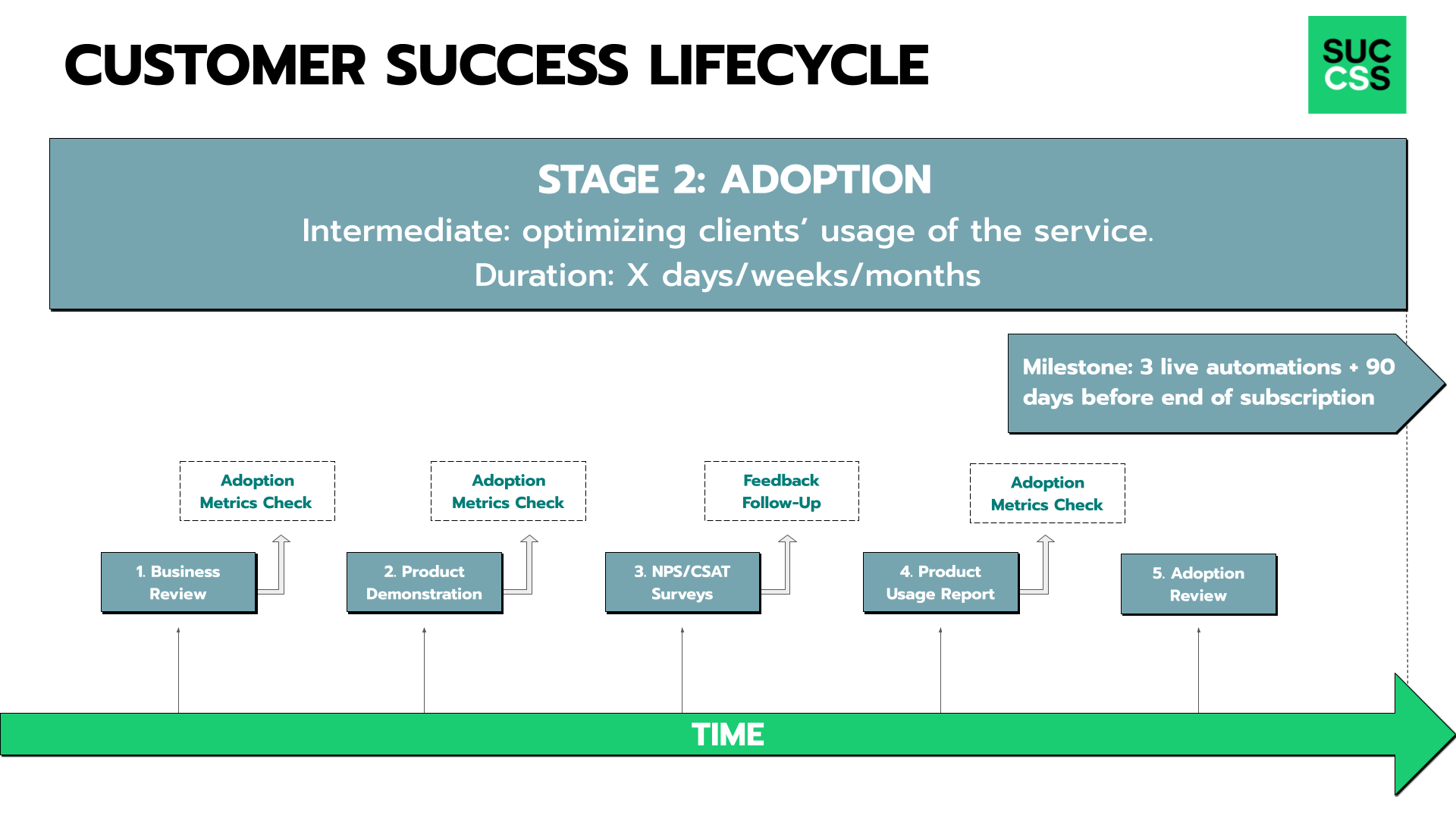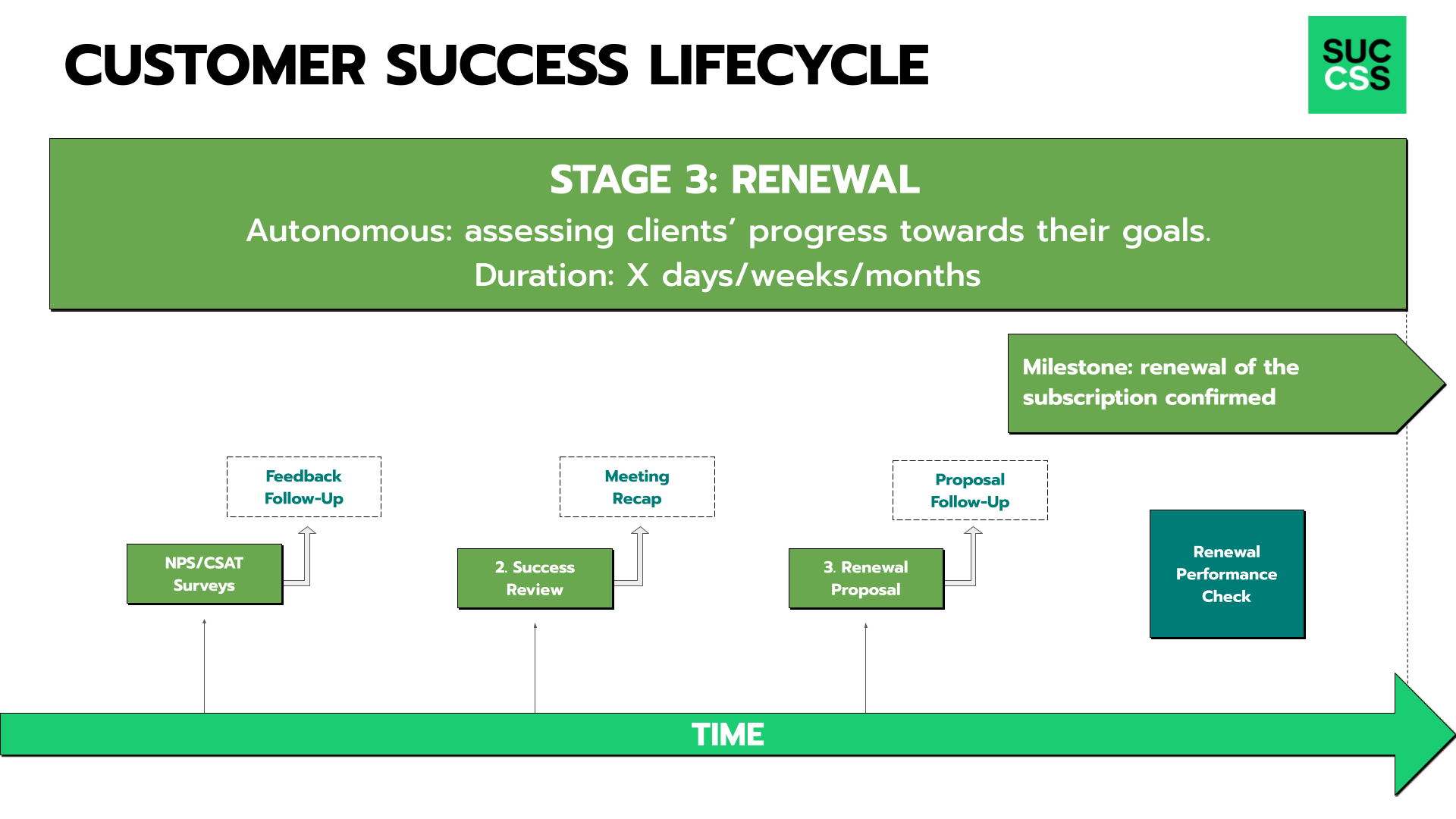#3-Onboard, Adopt, Renew
Table of content
1. Introduction
Look, we've already covered the big picture stuff - Chapter 2 showed you why keeping customers around is basically your golden ticket, and Chapter 3 gave you the playbook for making it happen. But now? Now we're rolling up our sleeves and getting into the nitty-gritty. Think of it like this: if customer success was a house, we've already walked through the floor plan and picked out the paint colors. This chapter is where we grab our tools and start building the thing, room by room. We're talking specifics here - what each stage means for your clients, what your CSMs need to be doing, and how it all ties back to keeping customers successful and sticking around. Sure, the previous chapters got you familiar with the landscape, but this is where we put on the hard hat and get our hands dirty.
2. Onboarding
Messing up a customer's first experience with your product is like burning the popcorn on movie night. There's no recovering from that moment. Whether you're selling enterprise software or ergonomic office chairs, those first few interactions after purchase are make-or-break territory. How come? Because it’s that time when you get to actually prove that the sales process was not just sweet-talking.
Done right, the onboarding process transforms uncertain newcomers into confident users who can actually get value from your product.
Studies show that companies that nail onboarding see dramatically higher retention rates, while those who leave customers to figure things out alone often watch them drift away. For example, in 2024, poor onboarding is the third most important reason for customers to churn, right after the wrong product fit and lack of engagement (Source) and 75% of users tend to abandon a product if it's hard for them to grasp how to use it within a week (Source).
The ultimate goal of the onboarding process is to get your customers to the "aha moment" when they understand how your product is going to help them achieve their goals.
A good onboarding process has positive ripple effects; it means fewer support tickets since well-trained customers need less hand-holding down the road. It also accelerates your execution speed, the faster you onboard a client, the faster you can help new clients get onboarded.
1. The Onboarding Checklist
Let me share a battle-tested onboarding playbook I've refined while leading CS teams at Strapi and Phantombuster (and still teach at Kare School).
Think of it as your recipe for turning "I just signed up" customers into "I couldn't live without this product" customers.
Here's what it looks like:
Play detective: Uncover what's really bugging your customer (and I mean really - not just the surface-level stuff). That’s when the root-cause analysis comes handy.
Get crystal clear on what "winning" looks like for them (with actual numbers to aim for)
Draft and share their roadmap to success
Show them exactly how your product gets them to the promised land
Hand them the instruction manual (docs, guides, and all that good stuff)
Keep tabs on their progress
Know when they're ready to take off the training wheels
Look, mastering your product is non-negotiable. You need to know what it does, who it's for, and how it makes their lives better. But here's a practical framework for measuring success that won't have you drowning in vanity metrics.
Let's break success into two buckets:
Value Metrics
These are the tactical improvements specific to someone's role. Think of them as the "Monday morning difference-makers."
At Typeform, this looked different depending on who was using the product:
Marketing folks needed lead-gen forms with custom tracking URLs
HR teams needed conditional logic to segment survey respondents
These metrics answer: "Is your product making their specific job easier or more effective?"
Business Impact
These are the high-level outcomes that get executives excited.
For that marketing team with their fancy tracking URLs? Their VP didn't care about the URLs—they cared about revenue from marketing qualified leads. That's business impact.
Get answers to these, and you'll have a success roadmap:
“Why did they decide to subscribe to your product/service?” (business impact)
"What bottom-line results do they expect?" (business impact)
"What will they be doing in your product day-to-day?" (value metrics)
"What does progress look like at 3, 6, and 9 months?" (value metrics)
With these answers, you'll see success through their eyes. And suddenly, building a strategy to get them there becomes remarkably straightforward.
Remember: if you can't articulate what winning looks like for your customer in one sentence, you probably don't know yet. Keep digging.
2. Touchpoints
Now, let's talk about when you actually need to show up. Here are the key meetings that matter:
Kickoff Meeting: Set the stage and understand what’s at stake
Product Demonstration: Show your product's magic
Progress Check: Make sure they haven't hit any walls
Onboarding Review: Check what's working and plan next steps
Here's the thing - resist the urge to add more meetings just because you can. Each touchpoint should move the needle toward a specific goal. In this case, the onboarding milestone. If you're scheduling calls just to "check in," you're doing it wrong. Remember, we're not here to be their new best friend - we're here to make them successful.
Think of these touchpoints like pit stops in a race - they need to be strategic, efficient, and actually help the customer move faster. Otherwise, you're just slowing them down.
Here's what a solid onboarding process looks like when you break it down into actual human interactions:
I've purposely kept timing flexible here because every product is different. It's like comparing a microwave (Typeform) to a commercial kitchen (Salesforce) - one you can figure out in 5 minutes, the other might take months to master.
Want to know how long your onboarding should really take? Dig into your product data and find out when customers start playing with the fancy features. That's usually a pretty good sign they've graduated from the basics.
No data to work with? Start with a two-month window and adjust based on what you see in the trenches. Remember, it's better to start with a longer runway and find out you don't need it than to rush people through and watch them crash and burn.
3. CSM role
Let's talk about how CSMs should actually show up during onboarding. At this stage, you want to be more Yoda - you're the wise guide who knows the way forward.
Here's how to nail it:
Master your product like a chef knows their kitchen. If you're dealing with technical stuff, don't fake it - bring in your tech experts when needed. And for CS leaders - this might mean hiring folks who can code. Better to have that expertise in-house than constantly playing catch-up.
Put the sales pitch on standby. Think about it, your customer just bought the thing - the last thing they want is another sales conversation. Save the "would you like to supersize that?" chat for when you've actually earned their trust.
Find the right balance with check-ins. You want to be like a good GPS - there when they need directions, but not constantly yapping about every turn. If your customers start dodging your calls, you're doing something wrong.
Remember, you're building a partnership here, not trying to win a popularity contest or hit a quota. Your only job right now is getting them to that "I can't believe I ever lived without this" moment.
4. Onboarding Metrics
Let's talk about onboarding metrics - and why there's no magic one-size-fits-all list I can hand you (though I would love to!).
Here's the real deal: you've got to build these metrics yourself, because nobody knows your product's success story better than you do.
Here's a tip that'll save you some headaches: sometimes it's easier to start at the finish line and work backwards. Think about it - if you know what "mission accomplished" looks like, you can figure out what breadcrumbs you need to track along the way.
Let me make this super concrete with a real example from my Phantombuster days. We needed to track:
How many automation scripts customers were cooking up (whether from scratch or using our templates - we weren't picky)
The number of social accounts they hooked up to each script (because a lonely script is a sad script)
What their scripts were actually doing (like automatically showing LinkedIn posts some love)
How often they were letting their scripts loose (daily, weekly, whenever)
Why these specific metrics? Because they all pointed to our ultimate "they get it" moment: having a live automation actually doing its thing in the wild.
Check these numbers regularly, like after each major touchpoint. It's like taking your customer's temperature - you want to catch any fever before it becomes a full-blown flu.
Don't fall into the vanity metrics trap. The number of emails you've sent or whether someone showed up to your demo? That's like counting how many times you've explained the rules of the game instead of tracking if they're actually playing it.
Here's a little secret: some of your best metrics come straight from your customers' mouths. That NPS survey you're probably dreading sending? It's gold. Or better yet, just ask them point-blank how confident they feel about using your product. Just remember - if they take the time to give you feedback (good or bad), you better take the time to do something about it.
And that’s how you want your lifecycle to look like:
3. Adoption
Let's talk about the adoption stage - you know, that critical moment when you stop hovering over your customers like a nervous parent and let them really fly with your product.
Think of it like teaching someone to ride a bike. The onboarding training wheels are off, and now you're watching them pop wheelies (or at least try to). But here's the thing - just because they can pedal without face-planting doesn't mean they're ready for the Tour de France.
What Does Real Adoption Look Like? It's not just about your customers clicking that shiny advanced feature once and calling it a day. Real adoption is when your product becomes their go-to tool to solve their main issues. When your software is so embedded in their daily workflow that not using it feels weird, that's when you know you've nailed it.
1. Adoption Checklist
Let's keep this simple. Here's your no-fluff checklist:
Make sure they really know their stuff
Show them the cool advanced moves they didn't know existed
Help them weave your product into their workflow like it was always there
Keep score and share the highlights
Know when they're ready to graduate to the next level
2. Touchpoints
Here's where the rubber meets the road. These are your key moments to shine:
Business Reviews (think casual check-up, not interrogation)
Advanced Feature Demo (the "wait, it can do that?" moments)
Customer Satisfaction Checks
Usage Reports (the proof is in the pudding)
Adoption Review (the "how's it really going?" conversation)
Pro tip: If your adoption stage is running longer than a season of your favorite TV show (3 months), feel free to repeat these touchpoints. Nine months? Two business reviews make perfect sense.
Here’s what we have this far:
3. CSM Role
During onboarding, you were the wise sage. Now? You're more like the streetwise pilot showing them all the shortcuts. Or Han Solo if you want to stick with the Star Wars analogy. "Hey, want to make this process twice as fast? Let me show you this cool trick." You're not teaching basics anymore - you're sharing insider tips that make them look like pros.
This is also when you start thinking about expansion opportunities. Customer maxed out their user licenses? Time to talk about upgrading. They could benefit from your other product? That's your cue to casually mention how it could solve their other headaches.
4. Adoption Metrics
You need concrete ways to track progress. Here's what worked at Phantombuster:
How many advanced scripts are they creating?
How many are actually live and kicking?
What's the average size of their scripts?
Are they connecting your tool with their other systems?
How quickly are they getting from idea to implementation?
Oh, and here's a golden nugget: Your Customer Health Score. Think of it as your early warning system - combining everything from NPS scores and usage data to support tickets into one "should I be worried?" number.
Remember, success in the adoption stage isn't just about usage - it's about making your product as essential to their workday as their morning coffee. When they start showing off your product to their colleagues like a proud parent, you'll know you've nailed it.
The result? This:
What if a customer is not adopting the product? Say no more. Here’s where to head to next: How to foster product adoption
4. Renewal
Alright, let's talk about the grand finale - the renewal stage. This is your championship round, where all those months of hard work either shine or... well, let's make sure they shine.
Think of this stage like presenting your year-end highlight reel, except instead of just showing off cool moments, you're connecting all the dots to tell a compelling story of success. You're basically the director of your customer's "How It Started vs. How It's Going" video.
Your main job? Be the data storyteller. You're pulling together everything from usage stats to customer feedback, turning raw numbers into a "wow, we really did that" narrative. It's like being an accountant, but for success - every win, every milestone, every "aha" moment gets tallied up.
While you're showcasing what's been accomplished, you're also dropping breadcrumbs about what's possible next. It's like showing someone who just mastered intermediate skiing the advanced slopes - "Look how far you've come... and check out where we could go next."
Now, let's address the elephant in the room - the stress of securing that renewal.
Renewals aren't random acts of customer kindness. They're the natural result of everything you've done right (or wrong) over the past months. If you've been doing your job - really understanding their problems, helping them hit their goals, being their product sherpa - then this should feel more like a victory lap than a nail-biter.
1. Renewal Checklist
Think of this less as a checklist and more as your winning strategy:
Get a real feel for customer sentiment (not just what they're saying, but what they're doing)
Build your case with hard evidence of their progress
Present a renewal plan that feels less like a contract and more like a roadmap to their next big wins
2. Touchpoint
Keep it simple but powerful:
Run that final satisfaction check (NPS/CSAT)
Lead a success review that feels more like a celebration than a presentation
Present your renewal proposal like you're outlining the next exciting chapter, not selling a used car
Remember: You're not closing a deal here - you're opening the door to the next level of success. If you've done your job right, this conversation should feel less like a negotiation and more like planning next season's championship run.
Now, here’s an overview of the Renewal Stage:
3. CSM Role
I have to confess, I don’t have any more fun Star Wars character analogy here. Instead, picture yourself as the project architect, not just a nervous vendor waiting for a "yes." Your key role is orchestrating a smooth renewal process that feels less like a high-pressure sales pitch and more like planning next season's game strategy.
First things first: don't wait until the contract's practically expired. You should be laying the groundwork for renewal months ahead (again depending on the specificities of your CS lifecycle). Think of it like planning a wedding - you don't start booking venues the week before, right?
Your main plays during this stage are:
Running a thorough health check of the account (usage data, support tickets, feedback, engagement levels)
Building a concrete business case showing ROI (with actual numbers, not just fluffy statements)
Mapping out what success looks like for the next contract period
Identifying and addressing any red flags before they become deal-breakers
Getting buy-in from all stakeholders
Here's what really makes a CSM shine during renewal: you're not selling the same thing again - you're selling the next level. If your first contract was about addressing their problem, your renewal should be about scaling their success. It's like upgrading from a GPS that just shows directions to one that actively helps avoid traffic jams.
Remember, your secret weapon is data. When a client says "We're not sure about renewing," your response shouldn't be panic - it should be "Let me show you how we helped you save $200K this year, and here's our plan to double that next year."
Bottom line: you're not just pushing papers for a signature. You're their advisor who's already got a vision for the next chapter of their partnership with your company. And if you've done your job right all year, the renewal meeting should feel more like a planning session than a negotiation.
The success review is a critical moment and can feel stressful. It’s okay. Here are some guidelines on how to approach it confidently:
First up, ditch the desperate "please don't leave us" energy. You're not begging for a second date; you're planning the next chapter of a successful partnership. As I explained earlier, you need to come prepared with cold, hard data about what you've achieved with your customer - like that 40% boost in efficiency they saw last quarter or the three major headaches your solution solved.
Start the conversation by asking about their next year's challenges. It's like asking "Where do you see yourself in five years?" but without the cringy interview vibes. This shows you're more interested in their future than your commission.
Secondly, when discussing money (that's always the elephant in the room), be as comfortable talking about the renewal fee as you are discussing lunch plans. If you act awkward about it, they'll feel it too. And nobody makes good decisions when they're feeling awkward.
4. Renewal Metrics
This part is quite straightforward. The one metric that matters here is the most important one: the renewal of the subscription. It’s a “yes/no” situation, which makes it easy to track.
That said, just because it worked for one customer doesn’t mean it will work for all of them. To get the whole story, you need to look at what’s happening across your entire portfolio.
Here are the metrics that actually matter when you're measuring renewal success.
Gross Revenue Retention (GRR) is like your relationship stability score - it tells you how good you are at keeping what you've got, ignoring any expansions. It's the "are we at least keeping our existing revenue?" metric. Anything below 85% and you might want to start updating your LinkedIn profile.
And here's one people often forget: Renewal Forecast Accuracy. Because being surprised by a non-renewal is like being surprised by a divorce when your partner's been sleeping on the couch for six months - you really should have seen it coming.
Remember we talked about expansions before? The best metric to both encapsulate your ability to retain existing customers while generating additional revenue is Net Revenue Retention (NRR). It’s your north star - think of it as your "did we actually grow or just stay afloat?" number. If you're not hitting at least 100%, you're basically treading water, and your boss probably isn't very happy. The best SaaS companies aim for 120%+ here.
Updating of the lifecycle, we now have this:
5. Resources
I created a free Customer Success Lifecycle. It’s fully-customisable so that you can easily add your own stages, touchpoints & milestones.
6. Conclusion
Let's wrap this up like a pro who's been in the CS trenches and lived to tell the tale.
Think of the customer success lifecycle like a well-choreographed dance - you start with the basic steps in onboarding, build up confidence during adoption, and nail the finale at renewal.
A killer onboarding sets the rhythm, turning uncertain newcomers into customers who actually get value from your product (because nobody wants to be that person still stumbling around the dance floor months later).
Then comes adoption, where you're basically teaching them the advanced moves - getting them to weave your product into their daily workflow like it's been there all along.
When renewal time hits, you're not scrambling to prove your worth - you're showing them the highlight reel of all the awesome moves they've mastered (with the data to back it up).
The real magic happens when you stop thinking about these stages as separate performances and start seeing them as one smooth routine, where each step naturally leads to the next. Remember, your job isn't to be the star of the show - it's to be the choreographer who makes your customers look good.
The whole game comes down to this: make your product so essential to your customers' success that not renewing would feel like showing up to a football game in flip-flops - technically possible, but why would you even consider it?







